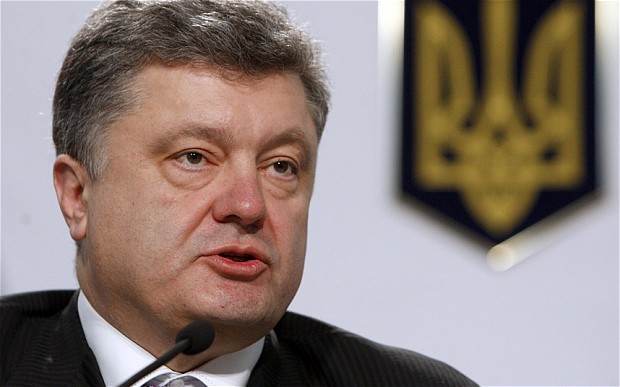
Russian Offensive Compels Ukraine to Accept Ceasefire Offer
Russian Offensive Compels Ukraine to Accept Ceasefire Offer
Ukrainian President Petro Poroshenko and the Donetsk and Luhansk “people’s republics” have issued parallel announcements today (September 4) about their mutual willingness to sign a ceasefire agreement tomorrow (September 5), subject to certain conditions that seem to be at hand. Russian President Vladimir Putin seems about to saddle Ukraine with the biggest of the “frozen conflicts” yet.
The Kremlin’s political objectives regarding Ukraine have evolved and shifted repeatedly from February (protection of a friendly Kyiv regime, then seizure of Crimea) through April–July (Novorossiya project) to date, with several options under consideration at any given juncture (Ukraine’s “federalization” being perhaps the most resilient among these options). Moscow’s primary option at this point is a Ukrainian “Transnistria-in-Donbas,” opening up further options, including Novorossiya, down the road.
Russia’s direct military intervention in Ukraine’s territory is forcing Poroshenko’s hand. Russia, however, would not be a party to any ceasefire, since Russia does not admit to being a party to the conflict, let alone to waging a war against Ukraine. The Kremlin is, instead, moving its proxies into the position of parties to an armistice. This would give the “people’s republics” a legitimate status in follow-up political negotiations and any subsequent agreements with Kyiv. The Kremlin would arbitrate the process, once started, and “guarantee” a settlement, if reached.
Putin’s latest round of military escalation has pushed Ukraine into this corner. On August 24, Russian Army battalion tactical groups launched an offensive against Ukrainian forces in the Donetsk and Luhansk provinces. Russian forces proved far superior in armor, firepower, logistics and training. Using paramilitary secessionists as mere auxiliaries, Russia’s regular forces have routed Ukrainian troops within ten days. In their wake, the Donetsk and Luhansk “people’s republics” have reclaimed significant territory that the Ukrainians had liberated during their own counter-offensive from late June through mid-August. The Ukrainian forces are now retreating with heavy losses in manpower and equipment (sprotiv.info, August 25–September 3).
The Ukrainian encirclement of Donetsk city and Luhansk city has been broken. The land corridor between the two “people’s republics” has been restored. Additional portions of the Russia-Ukraine border have come under Russian and proxy control on both sides, enabling unrestricted cross-border movements of troops and supplies. The retreating Ukrainian forces intend to form a frontline for positional defense across the central parts of Donetsk and Luhansk provinces. Russian forces, however, have opened a new front in the south. Moving from Russia’s Rostov oblast into Ukraine along the Azov Sea coast, they threaten to open a land corridor from Russia to the Russian-annexed Crimea (Ukrinform, August 25–September 3).
Russian President Vladimir Putin is now moving to exploit his battlefield successes politically. Rather than wait for Kyiv to sue for peace, Putin is offering a deal to Ukrainian President Petro Poroshenko. The offer includes a heavily-conditioned ceasefire and subsequent political negotiations on Russian-defined terms. Putin is testing Poroshenko to see whether the Ukrainian president will go along.
On September 3, Putin made public a seven-point ceasefire plan (see accompanying article) and conferred with Poroshenko by telephone about a possible implementation process. According to the Ukrainian president’s office, they “agreed in broad terms” about “steps to take that would facilitate a ceasefire.” According to the Kremlin, “their views coincided to a significant extent” about “priority actions to stop the bloodshed as soon as possible” (president-gov.ua, kremlin.ru, September 3).
Those official announcements were initially misunderstood as signifying an actual ceasefire agreement; but the confusion was quickly cleared up in both Kyiv and Moscow. Their terms were yet to be finalized. Those announcements did not clarify which president had initiated the call. It seems to have been Putin, while overflying Siberia en route to Mongolia and calling Poroshenko at 5 a.m. Ukrainian time (Interfax, September 3).
Moscow has insisted all along that it cannot, by definition, become involved in ceasefire negotiations because it is not a party to this conflict (see above). Putin and Foreign Affairs Minister Sergei Lavrov often said that Russia “has no right” to participate in ceasefire talks, that being a “right” of the two “people’s republics”—i.e., their claim to see themselves legitimized. The Putin-Poroshenko telephone call dispelled that pretense, but no one seems prepared to hold Russia accountable.
Neither side has yet clearly defined the parties to a possible ceasefire agreement. That definition—whether Russia versus Ukraine, or local rebels versus the Ukrainian government—would pre-determine the course of any subsequent negotiations. The Kremlin characterizes this conflict as internal to Ukraine, casting Russia as a mediator. For Ukraine to paper this over (as in the September 3 announcements), or to go forward in ambiguity on this issue, would amount to conceding defeat in advance.
Clearly, Putin wants an agreement to be signed by Kyiv with the two “people’s republics” in the framework of the easily managed “Contact Group”—Russia, Ukraine, Organization for Security and Cooperation in Europe (OSCE), and the Donetsk-Luhansk “republics”. The Contact Group’s meeting is scheduled to be held in Minsk on September 5.
Poroshenko hopes to bring five points of his own to that meeting. The “Poroshenko plan” includes (in this order):
1. a “bilateral” ceasefire;
2. ceasefire verification and monitoring by the OSCE;
3. “withdrawal of all foreign forces from Ukraine’s territory” (Russia and the “people’s republics” will likely seek themselves to define what foreign forces are and what Ukraine’s territory is);
4. creation of a buffer zone along the Russia-Ukraine border (no specifics yet);
5. release of Ukraine’s citizens detained illegally in Russia (president-gov.ua, Ukrinform, September 5).
Poroshenko called German Chancellor Angela Merkel on September 3, seeking her support for his proposals. The Ukrainian president hopes to combine his five points with Putin’s seven-point plan (see accompanying article).


